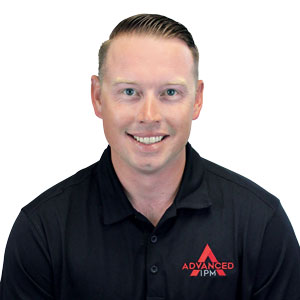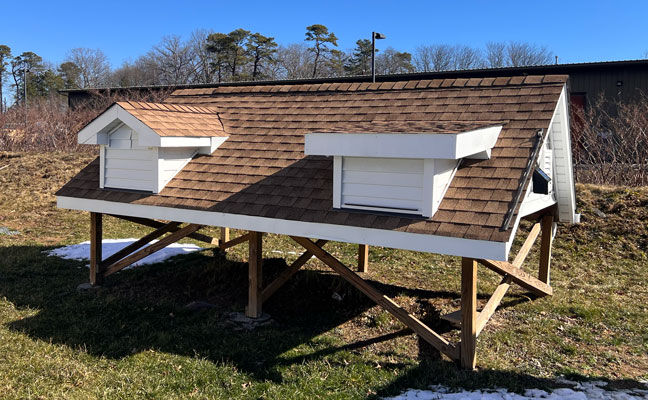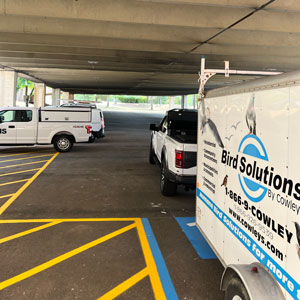
A Southern California pest control company installs Bird Barrier’s Bird-Shock on steel louvres at a hospital, protecting an outdoor dining area below. PHOTO: BIRD BARRIER AMERICA
For Pest Management Professional’s (PMP’s) 2024 State of the Industry survey, approximately one-third of readers surveyed reported they offer bird management among their services. Another 8 percent said they would begin offering bird service this year. Anecdotally, readers tell PMP they have tried bird control in the past, and it was just too much work. Others say once they got the hang of it, it’s well worth the legwork involved. That bears out in our survey results, as nearly 4 percent of respondents said it was among their Top 5 Service Sellers, and nearly 7 percent said it was among their Top 5 Margin Makers.
It seems, then, that for those who have cracked the code on how to succeed in bird control can really reap the rewards — namely, high revenue and another service to market to new and existing customers, strengthening brand name and loyalty.
Different paths to bird success

Ryan Gates
Drew Cowley, president of Cowley’s Termite & Pest Services, based in Farmingdale, N.J., went from knowing very little about bird control three decades ago to serving as the current president of the National Wildlife Control Operators of America (NWCOA) organization, which offers accredited training for the control of birds in addition to bats, skunks and other pests.
Cowley recalls his first official bird control job, just three years into business. “It was an existing warehouse account that had a starling problem in the loading dock area, and I was lucky I did a good job. I was using netting instead of something simpler like exclusion or spikes. I don’t recommend starting off with that degree of difficulty!”
Ryan Gates, ACE, is technical services manager for Versacor Enterprises. He says the Southlake, Texas-based firm has been offering bird control services since shortly after its founding in 2009. It’s a solid part of the company’s identity today.
“As with so many programs, our adoption was driven by client demand and perceived value,” he explains.

Travis Curtis
Similarly, Travis Curtis, ACE, reports that bird control started off by growing organically among existing accounts at the Advanced IPM branches he manages in Manteca, Merced, Madera and Bakersfield, Calif. “We were doing well,” he adds, “But we knew we could do even better if we could approach bird control more strategically, tailoring our services to the unique demands of each situation.”
To gain this expertise, Curtis took a bird control sales course offered by an industry manufacturer to “train the trainer” — that is, he could take what he learned and implement it among his bird control team, both sales and technical. He offers his three biggest takeaways after taking the extra training:
- “In-depth product knowledge is crucial for recommending the most effective solutions tailored to the specific pest bird and the level of pressure in each case.”
- “Hands-on installation training has been invaluable because it has helped us fine-tune our process. It also ensures our team now can not only recommend and price, but also correctly implement the solutions we provide.”
- “Ongoing support from and collaboration with the manufacturing team — from choosing the right products for each job to advising on pricing strategies — has been a cornerstone of our improved service delivery.”
To get his crew certified through NWCOA and various suppliers, Cowley conducts Tuesday morning wildlife training sessions, with bird control being the topic at least once a month. “It lasts from 7 a.m. to 8 a.m.,” he says. “Plus, I’m a certified NWCOA trainer and I can give additional training in our mockup roof at the office.”
The benefit of hindsight
Cowley’s Top 2 recommendations to pest control firms seeking to establish or fine-tune their bird control services is to start small and separate the business from the rest of their offerings. He speaks from experience, having incorporated Bird Solutions by Cowley’s as a division separate from the main business of pest control.
“I see it as changing the perception of expertise,” he explains. “I didn’t want to be ‘the pest control guy doing bird control,’ especially when bidding for accounts against 100 percent bird and wildlife companies. I saw it in my personal life, too, as in, do I want the ‘pool cleaning guy’ to also be my ‘fence guy’? Is he going to be equally good at both? But if it’s two divisions from a company I trust, that’s a different story.”

Cowley’s Termite & Pest Services has a mock rooftop on its headquarters property for technicians to learn and brush up on bird control skills. Photos: Cowley’s Termite & Pest Services
In fact, Cowley says, it’s how all six divisions in his company are treated, including “… by Cowley’s” for mold solutions, holiday décor, “Little Rascals” (wildlife), crawlspace solutions and gutter protection. “Pest control services is the hub,” he explains, “but we have expert teams for each division.”
While Gates joined Versacor after its bird control service had been established, his industry experience leads him to point to what might be the weakest link in many companies’ programs: the initial inspection and proposal.
“There are so many variables to consider, from the environment to the type of bird to the techniques applied, that it is very easy to miss something,” Gates explains. To combat this problem, he suggests formalizing a training program and increasing the amount of training required for individuals who will be selling bird services. In other words, if you think you’ve adequately spelled it out, you probably have not — and it’s hard to be “overtrained” in this regard.
“At Versacor, we’ve implemented a specific internal procedure for proposing and selling bird services, designed to improve cooperation between our sales and service departments,” Gates says. “History has shown it is critical that the service team agrees with the sales team before the bird service is even sold.

Cowley’s Termite & Pest Services has a mock rooftop on its headquarters property for technicians to learn and brush up on bird control skills. Photos: Cowley’s Termite & Pest Services
We require that the sales team has the support of service management before the bird service is presented to the client. In more complicated situations, we will revisit the site with someone from the service team to get a second set of eyes on situations and reevaluate.”
Advanced IPM’s Curtis adds that budgeting time and expense for specialized and ongoing training from bird control suppliers, distributors and associations is practically a must, as it can significantly expand your team’s expertise. “Just having a supportive network that’s a phone call or text away can significantly impact the quality of service and customer satisfaction,” he points out.
If Cowley had to do it over again, he wishes he had learned to delegate sooner — perhaps still by starting as a “one-man show,” but at least with a part-time helper who could flourish in the role and eventually become division manager.
“I realize that probably wouldn’t have been economically feasible at that time,” he admits. “But as we found success, I held on too tightly. That’s the wrong attitude, because as your company grows, you’ve got to let go. You must have confidence in your team and train them properly; your business will grow faster.”
Manage customer expectations
Another factor, Gates says, lies in how bird control services are marketed.
“It sounds impressive to guarantee ‘elimination’ with any pest control service, but with most bird services, elimination is not a viable result,” he adds. “With so much bird work focusing on exclusion and habitat alteration, we can reliably keep birds from nesting or roosting in areas where they aren’t wanted, but birds tend to do this funny thing called ‘flying’ that makes it difficult to simply keep them off the property.
“Being realistic about the outcome, and transparent with clients on what they can expect to see after services are performed are critical,” Gates says, offering as an example: “Yes, we will keep the birds from nesting in your sign, but you may still see them in the parking lot.”

Cowley’s Termite & Pest Services brands each of its divisions as ____ By Cowley, so that the businesses stand alone, yet unite under the Cowley brand. Photo: Cowley’s Termite & Pest Services
Manage your expectations
Gates points out PMPs need to be realistic about their bird control capabilities, based on the manpower, time, equipment and expertise they have.
“Bird work tends to be costly and labor-intensive, which can come back to bite you if it is not sold well or performed correctly,” he explains. “Don’t get distracted by the dollar signs, only to find out your team has no experience with the product and no clue how to install it, or for a team of guys to spend a week’s worth of labor installing a system that won’t be effective at solving the problem.”
There’s no shame, Gates points out, “in walking away from a job that isn’t within your skill set.”
Still, the better equipped and trained your team is, such situations should be few and far between, notes Curtis. “Since beginning to offer enhanced bird control services,” he concludes, “we’ve learned to adapt and refine our sales approach continually. This includes understanding that each client’s needs are unique, and being receptive to feedback, both from customers and team members. This has helped us stay agile and effective.”
Choose your team wisely

Drew Cowley
Drew Cowley, president of Cowley’s Termite & Pest Services, is always on the lookout for talented bird control technicians. He recalls how about three years ago, he happened to see and then read the resume of a new hire for the general pest control team. “Keith’s experience was listed as being a roofer, a tradesman and a handyman,” Cowley recalls. “I walked right over to the pest control team and said, ‘Not so fast, I’m taking him for the bird team!’”
Cowley pounced because he had been burned in the past. “I had an experience with another new hire who just froze up on the roof with me. He was so scared that I was worried we’d have to call someone to get him down,” he says, noting that the man finally found a way to conquer his fear and get down the ladder (and onto another job).
Nowadays, during the interview process, Cowley takes the applicant to the company’s warehouse and has him or her climb a 25-foot ladder as he watches for signs of confidence. “Too many people say, ‘Oh, I can do heights, no problem,’ when the reality is they’ve never climbed a ladder in their lives,” he says. Still, if they are good with tools and willing to work, Cowley can usually find a spot for acrophobic applicants — just in another division of the company.
Leave A Comment